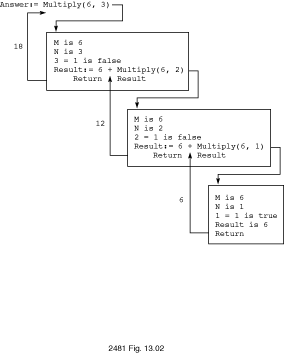
Hand-tracing an algorithm's execution provides us with valuable insight as to how that algorithm works. We can also trace the execution of a recursive procedure or function. We will illustrate how to do this by studying a recursive function next.
In the last section, we wrote the recursive function Multiply
(see Program
13.1). We can trace the execution of the function call
Multiply(6,3) by drawing an activation frame corresponding
to each call of the function. An activation frame shows the parameter values
for each call and summarizes its execution.
The three activation frames generated to solve the problem of multiplying 6
by 3 are shown in
Figure
13.2. Each downward arrow indicates a recursive call of the function; the
arrow is drawn starting from the line of the activation frame in which the
recursive call is made. The value returned from each call is shown alongside
each upward arrow. The upward arrow from each function call points to the
operator + because the addition is performed just after the return.
Figure 13.2
Answer := Multiply(6,3)

Figure 13.2
shows that there are three calls to function Multiply. Parameter
M has the value 6 for all three calls; parameter N
has the values 3, 2, and finally 1. Because N is 1 in the third
call, the value of M (i.e., 6) is returned as the result of the
third and last call. After returning to the second activation frame, the value
of M is added to this result and the sum (i.e., 12) is returned as
the result of the second call. After returning to the first activation frame,
the value of M is added to this result and the sum (i.e., 18) is
returned as the result of the original call to function Multiply.
M,
N, and Result at any given point. Ada uses a special
data structure, called a stack, that is analogous to a stack of dishes
or trays. Think of the countless times you have stood in line in a cafeteria.
Recall that clean dishes are always placed on top of a stack of dishes. When we
need a dish, we always remove the one most recently placed on the stack. This
causes the next to last dish placed on the stack to move to the top of the
stack.
Similarly, whenever a new function call occurs, the parameter values associated
with that call are placed ("pushed") on the top of the parameter stack. Also, a
new cell whose value is initially undefined is placed on top of the stack that
is maintained for the local variable Result. Whenever
M, N, or Result is referenced, the value
at the top of the corresponding stack is always used. When a procedure return
occurs, the value currently at the top of each stack is removed ("popped"), and
the value just below it moves to the top, just as in the cafeteria stack.
As an example, let's look at the three stacks right after the first call to
Multiply (but before Multiply does any work). There
is one cell on each stack, as shown below. Result has no value
yet, because Multiply computes it.
After first call to Multiply:
M N Result |6| |3| |?|Just after the second call to
Multiply, the number 2 is
placed on top of the stack for N, and the top of the stack for
Result becomes undefined again as shown below. The top cells
represent the top of each stack.
After second call to Multiply:
M N Result |6| |2| |?| |6| |3| |?|
Multiply
is called again, and this time the number 1 is placed on top of the stack.
After third call to Multiply:
M N Result |6| |1| |?| |6| |2| |?| |6| |3| |?|Because
1 is the stopping case, Result can be computed.
After first computation of Result:
M N Result |6| |1| |6| |6| |2| |?| |6| |3| |?|The function can now return, which causes the values at the top of the stack to be removed. Because
Multiply was called in a statement that computes
Result, a new value of Result is placed on top of the
stack.
After first return and second computation of Result:
M N Result |6| |2| |12| |6| |3| |?|The function can now return yet again and compute a new value of
Result.
After second return and third computation of Result:
M N Result |6| |2| |18|Finally, we return to the main program; the final value of
Result is left
on top of the stack, where it can be picked up and copied into
Answer.
After third return:
M N Result |?| |?| |18|Because these steps are all done automatically by Ada, we can write recursive subprograms without needing to worry about the stacks.
We have introduced the stack here as a way to explain how recursive calls can be implemented. However, stacks are used by most programming languages to implement all subprogram calls, not just recursive ones. Indeed, recursive calls are really just a special case in which the calling and called subprograms are the same.
Multiply(5,4) and show the stacks
after each recursive call.
Copyright © 1996 by Addison-Wesley Publishing Company, Inc.